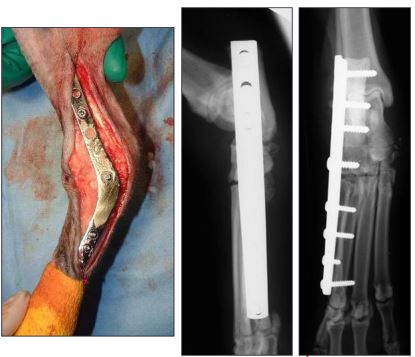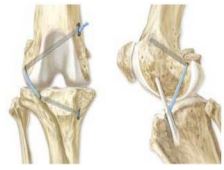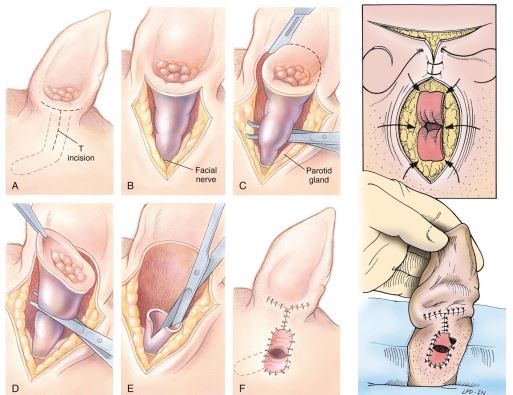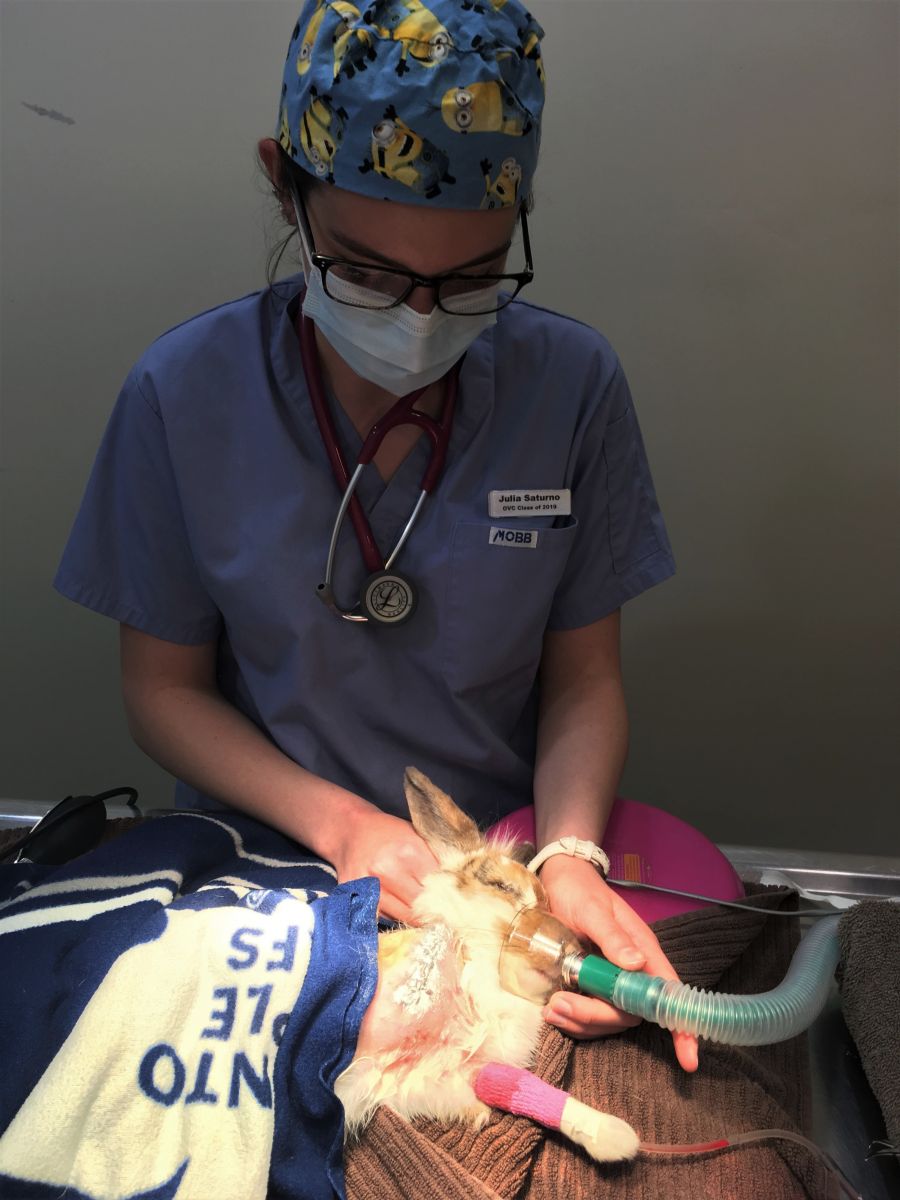These past couple of weeks at the clinic have been particularly busy since we have been completely booked with referral surgeries. In addition to the usual spays, neuters and mass removals there have been many orthopedic and more complicated surgeries scheduled. When non-routine surgeries need to be booked for patients, a freelance referral surgeon comes into the clinic to perform them. This offers clients a more flexible, and sometimes less expensive, option than being referred out to specialty hospitals. Clients have the peace of mind that the veterinarians and staff they are familiar with will be involved in the surgery process and will be the ones taking care of their pets post-op. In some cases, it can be in the best interest of the patient to be referred to specialty hospitals when intensive 24/7 care is necessary, but when this is not the case many clients prefer to have their pets treated in New Hamburg.
In just a couple of weeks I have been able to watch a joint arthrodesis, an extracapsular “tight-rope” cruciate ligament repair and an ear canal ablation performed. Although I know I do not want to specialize in surgery when I graduate, it has been fascinating being able to watch these surgeries and actually witness what I have learned in lectures this past year. The following diagrams/images are screen shots from lectures in the Phase 3 Dog and Cat Surgery and Medicine course. I didn’t think I would be able to see surgeries such as these performed until my surgery rotation at OVC later this year. I am very fortunate to be doing my externship at a practice that is able to offer these complex surgeries!
 A joint arthrodesis is performed to fuse a joint that has undergone a hyperextension injury. Our patient had experienced a trauma that had hyperextended the tarsal joints in her hind-limb causing a subluxation (or instability) of the joint. Conservative treatment was attempted first, but after a month or so it was deemed that surgical intervention was necessary. After the articular cartilage was removed, a bone plate was placed to keep the joint immobile and stable until boney fusion can occur, the patient is now pain free and starting to walk with the affected limb again!
A joint arthrodesis is performed to fuse a joint that has undergone a hyperextension injury. Our patient had experienced a trauma that had hyperextended the tarsal joints in her hind-limb causing a subluxation (or instability) of the joint. Conservative treatment was attempted first, but after a month or so it was deemed that surgical intervention was necessary. After the articular cartilage was removed, a bone plate was placed to keep the joint immobile and stable until boney fusion can occur, the patient is now pain free and starting to walk with the affected limb again!
 An extracapsular “tight-rope” surgery is performed to replace and mimic a ruptured cranial cruciate ligament. Rupturing the cruciate ligament is a very common injury seen in dogs and the “tight-rope” surgery is a great option for smaller dogs and for clients who cannot afford the more expensive and intensive Tibial Plateau Leveling Osteotomy (TPLO) surgery. The cranial cruciate ligament in the stifles of dogs is the equivalent to the “ACL” ligament in the knees of humans. The tight-rope provides stability to the stifle joint until fibrosis develops and permanently stabilizes the joint.
An extracapsular “tight-rope” surgery is performed to replace and mimic a ruptured cranial cruciate ligament. Rupturing the cruciate ligament is a very common injury seen in dogs and the “tight-rope” surgery is a great option for smaller dogs and for clients who cannot afford the more expensive and intensive Tibial Plateau Leveling Osteotomy (TPLO) surgery. The cranial cruciate ligament in the stifles of dogs is the equivalent to the “ACL” ligament in the knees of humans. The tight-rope provides stability to the stifle joint until fibrosis develops and permanently stabilizes the joint.
 An ear canal ablation is performed when a patient has chronic middle ear infections (otitis media) and it is best to remove the vertical and horizontal ear canals altogether. This patient in particular had an ear tumour within the vertical ear canal that made it very difficult to keep the ear clean, which was perpetuating the ear infections.
An ear canal ablation is performed when a patient has chronic middle ear infections (otitis media) and it is best to remove the vertical and horizontal ear canals altogether. This patient in particular had an ear tumour within the vertical ear canal that made it very difficult to keep the ear clean, which was perpetuating the ear infections.
During surgery the cartilage of the ear canal is physically removed and a hole is made lower in the ear to allow drainage. The patient is able to retain the ability to hear and the the hole created lower in the ear is only a slight cosmetic alteration. Luckily our patient was a hound dog and had long floppy ears to hide the fact that any surgery was performed in his ear canal!
 My favourite referral surgery that I have witnessed here was the forelimb amputation performed on a rabbit patient! Linda, our very adorable patient, unfortunately sustained a debilitating humoral fracture and it was deemed that amputation was necessary for the best prognosis. Rabbits are quite different than dogs and cats when it comes to surgery, and using anesthesia on them is a much more difficult process. Rabbits are very sensitive to pain and metabolize certain drugs a different way than other species, so special care must be taken when choosing the correct anesthesia and pain control medications. It is also very important to have rabbits eat as soon as possible after surgery in order to maintain the integrity of their sensitive gastro-intestinal tracts after anesthesia. Hay, pellet, and special treats like bananas are all offered on recovery to get them eating quickly.
My favourite referral surgery that I have witnessed here was the forelimb amputation performed on a rabbit patient! Linda, our very adorable patient, unfortunately sustained a debilitating humoral fracture and it was deemed that amputation was necessary for the best prognosis. Rabbits are quite different than dogs and cats when it comes to surgery, and using anesthesia on them is a much more difficult process. Rabbits are very sensitive to pain and metabolize certain drugs a different way than other species, so special care must be taken when choosing the correct anesthesia and pain control medications. It is also very important to have rabbits eat as soon as possible after surgery in order to maintain the integrity of their sensitive gastro-intestinal tracts after anesthesia. Hay, pellet, and special treats like bananas are all offered on recovery to get them eating quickly.
 Linda was an absolute superstar during her surgery and her recovery was as smooth as can be. Within one day she was eating normally and learning how to hop properly on three legs!
Linda was an absolute superstar during her surgery and her recovery was as smooth as can be. Within one day she was eating normally and learning how to hop properly on three legs!





